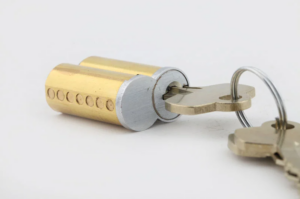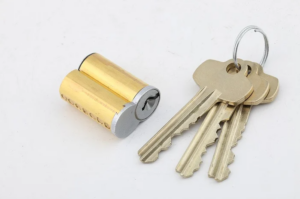An IC core lock, or Interchangeable Core lock, enhances security and key management in different places. It allows easy rekeying without changing the lock, saving money and time. The lock uses a pin tumbler system where the correct key aligns pins at the shear line, letting the core rotate and unlock the door. A control key removes the core for effortless rekeying. Let’s explore IC core locks, their advantages, and how they ensure a secure environment.
What is an IC core lock?
People use an IC core lock in commercial and residential buildings for security. It stands for “Interchangeable Core” lock. The key feature of this lock is its interchangeable cylinder, which allows for quick and easy rekeying without the need to disassemble the entire lock.
The lock has two main parts: the lock housing and the interchangeable core. The lock housing represents the external part of the lock, and people mount it on the door. The interchangeable core is the internal part containing the tumblers and key pins.
Rekeying an IC core lock is a breeze. People use a specially designed control key to remove the core and can insert a new core with a different key combination. This process saves time and money, especially when key access is frequently changed, like in offices or rental properties.

Types of IC cores
IC cores, or Interchangeable Cores, are a type of lock cylinder used in various applications for convenient and secure key management. They offer the advantage of easy rekeying without disassembling the entire lock. Let’s explore the different types of IC cores in detail:
Standard IC Core:
This is the fundamental and most commonly used type of IC core. It consists of a plug (cylinder) that can be easily removed using a control key. Once you remove the plug, you can change the key pins and springs to create a new keying combination, enabling quick rekeying.
Small Format IC Core (SFIC):
Designers create SFIC cores to be compact, making them suitable for limited-space applications like cabinets, drawers, and small padlocks. Despite their size, they still provide the convenience of rekeying.
Large Format IC Core (LFIC):
LFIC cores are larger and more robust on the other end of the spectrum, intended for heavy-duty applications such as commercial doors and access control systems. They offer enhanced durability and security.
Uncombinated IC Core:
This core type comes without preset pin combinations, allowing locksmiths to create custom keying systems based on specific requirements. This is ideal for large facilities or properties with unique security needs.
Combined IC Core:
Combinated cores come with pre-set pin combinations, ready for quick installation without rekeying. This simplifies the key management process and is often used in standard security setups.
Master Keyed IC Core:
A master-keyed IC core enables one key to operate multiple locks while each lock retains its own key. This is useful in buildings with different access levels, granting convenience to authorized personnel.
Construction Master Keyed IC Core:
During construction or renovation projects, contractors use a construction master key to access all locks, while the building owner retains a separate key. Once the project is complete, the owner can rekey the system for their exclusive use.
Grand Master Keyed IC Core:
This sophisticated system caters to large-scale facilities with multiple access levels. It allows for multiple master keys, each operating a specific set of locks, granting access to designated areas only.
How To Do Ic Core Locks Work?
IC core locks, also known as Interchangeable Core locks, operate using a clever pin tumbler mechanism that provides both convenience and security. Let’s take a closer look at how these locks work:
Key Insertion: When you insert the key into the lock’s keyway, the key’s unique shape interacts with a series of pins inside the lock.
Pins Arrangement: Inside the lock are two sets of pins: key pins and driver pins. The key pins are different lengths and rest on the driver pins.
Shear Line Alignment: As you turn the key, the key pins and driver pins align at what’s called the “shear line,” creating a gap between the lock’s outer cylinder (housing) and the inner core (plug).
Plug Rotation: The gap between the housing and the core allows the core to rotate freely within the lock.
Locking and Unlocking: When you use the correct key, its unique combination lifts the pins to the correct height, aligning the shear line and enabling the core to rotate freely, thus unlocking the lock.
Control Key Access: In an IC core lock, a special “control key” can remove the entire core from the housing, exposing the control shear line.
Control Pin Function: The control key contains a unique control pin that stops regular operating keys from removing the core.
Rekeying Convenience: To rekey the lock, use the control key to remove the core and access the pin chambers.
Adjusting the Combination: By changing the length of the key pins, you can create a new combination corresponding to a different key.
Master Key Systems: IC core locks are highly versatile, making them suitable for master key systems where one key operates multiple locks while each lock still retains its key.

Benefits of Interchangeable core locks
Easy Rekeying: Swiftly change key combinations without replacing the entire lock, saving time and money.
Flexible Key Management: Ideals for facilities with changing access needs, like offices and rental properties.
Master Key Systems: Facilitate multiple access levels with one key operating several locks.
Control Key Access: The control key allows for core removal and effortless rekeying.
Customizable Security: Choose between uncombined or combined cores for tailored keying systems.
Convenient Construction Phase: The construction master key system simplifies contractor access during the building phase.
Enhanced Security: Prevents unauthorized key duplication due to restricted access to the control key.
Suitable for Various Applications: Used in commercial, institutional, and residential settings for optimal security.
Compatibility: Interchangeable cores can fit into different lock styles, such as knobs, levers, and deadbolts.
Versatility: Available in small format for limited space and large format for heavy-duty applications.
